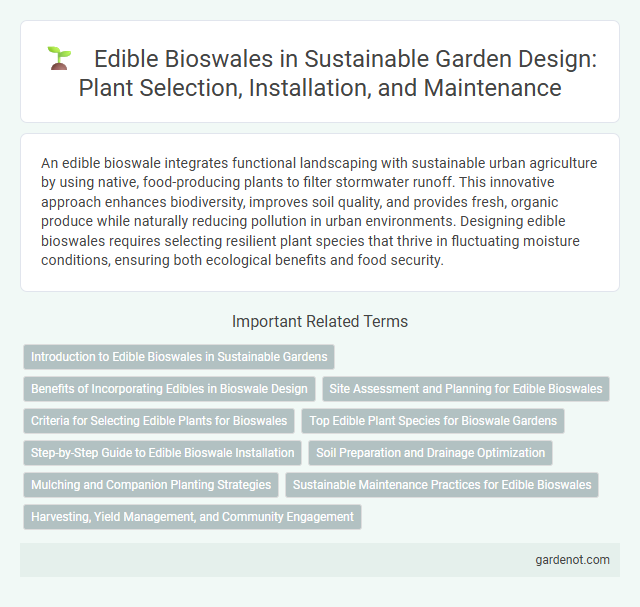An edible bioswale integrates functional landscaping with sustainable urban agriculture by using native, food-producing plants to filter stormwater runoff. This innovative approach enhances biodiversity, improves soil quality, and provides fresh, organic produce while naturally reducing pollution in urban environments. Designing edible bioswales requires selecting resilient plant species that thrive in fluctuating moisture conditions, ensuring both ecological benefits and food security.
Introduction to Edible Bioswales in Sustainable Gardens
Edible bioswales integrate water management with food production by channeling rainwater through nutrient-rich soil beds planted with edible crops. These green infrastructures reduce stormwater runoff, improve soil health, and enhance urban biodiversity while providing fresh vegetables, herbs, and fruits. Incorporating native, drought-tolerant plants maximizes sustainability in diverse garden environments.
Benefits of Incorporating Edibles in Bioswale Design
Incorporating edibles in bioswale design enhances stormwater management while providing a sustainable source of fresh produce, promoting food security in urban environments. Edible bioswales improve soil health through organic matter retention and natural filtration, reducing pollutants and enhancing water quality. These systems foster biodiversity by attracting pollinators and beneficial insects, contributing to ecological balance and community well-being.
Site Assessment and Planning for Edible Bioswales
Site assessment for edible bioswales involves analyzing soil quality, sunlight exposure, and hydrology to ensure optimal plant growth and water filtration. Planning includes selecting native edible plants that can thrive in local climate conditions while maximizing stormwater absorption and pollutant removal. Proper grading and soil amendments are essential to support plant health and enhance the bioswale's ecological function.
Criteria for Selecting Edible Plants for Bioswales
Edible plants selected for bioswales must demonstrate high tolerance to fluctuating water levels and poor soil conditions, ensuring effective stormwater management and pollutant filtration. Preference is given to native, drought-resistant species with deep root systems that stabilize soil while supporting local ecosystems and providing food resources. Plants should also have minimal maintenance requirements and be non-invasive to preserve the bioswale's ecological balance and functionality.
Top Edible Plant Species for Bioswale Gardens
Top edible plant species for bioswale gardens include native perennials like Asparagus officinalis, Echinacea purpurea, and Vaccinium corymbosum, which enhance soil filtration and provide food sources. Incorporating Allium species such as garlic and chives improves pest resistance while supporting water retention in bioswale environments. These plants optimize stormwater management by promoting infiltration and reducing runoff, making them ideal for sustainable urban landscapes.
Step-by-Step Guide to Edible Bioswale Installation
Preparing an edible bioswale involves selecting native, drought-tolerant plants such as kale, chard, and herbs that thrive in rainwater runoff conditions. Excavating a shallow trench with sloped sides ensures optimal water infiltration and prevents erosion while adding a layer of compost-rich soil improves nutrient retention for edible crops. Installing an overflow outlet and mulch layer helps manage excess water flow and maintain soil moisture, promoting healthy plant growth and maximizing stormwater filtration.
Soil Preparation and Drainage Optimization
Edible bioswales require well-prepared soil with a balanced mix of organic matter, sand, and compost to enhance nutrient retention and support diverse plant growth. Proper grading and incorporation of permeable soil layers improve water infiltration, preventing waterlogging while ensuring efficient drainage. Strategic placement of drainage pipes or gravel trenches accelerates excess water removal, optimizing both soil moisture and plant health.
Mulching and Companion Planting Strategies
Mulching in edible bioswales enhances soil moisture retention, suppresses weeds, and improves nutrient cycling, creating optimal growing conditions for diverse plant species. Companion planting strategies, such as pairing nitrogen-fixing legumes with nutrient-demanding vegetables, boost soil fertility and pest resistance naturally. Integrating organic mulches like straw or wood chips with carefully selected companion plants maximizes the bioswale's productivity and ecological benefits.
Sustainable Maintenance Practices for Edible Bioswales
Sustainable maintenance practices for edible bioswales emphasize organic soil enrichment, water-efficient irrigation, and integrated pest management to promote healthy plant growth and nutrient-rich yields. Using compost and mulch reduces water evaporation and enhances microbial activity while drip irrigation minimizes water waste. Regular monitoring and selecting native, edible species ensure resilience and long-term productivity within bioswale ecosystems.
Harvesting, Yield Management, and Community Engagement
Edible bioswales optimize urban green infrastructure by integrating food-producing plants, enhancing both stormwater management and local food supply. Effective harvesting schedules and yield management techniques promote consistent crop production while maintaining soil health and water filtration capacity. Community engagement initiatives foster stewardship and educational opportunities, encouraging local participation in sustainable food systems and environmental conservation.
Edible bioswale Infographic

 gardenot.com
gardenot.com